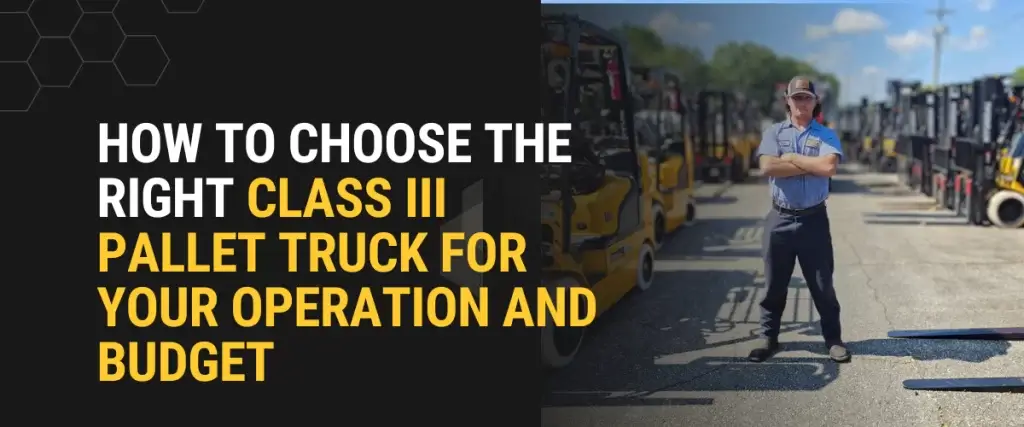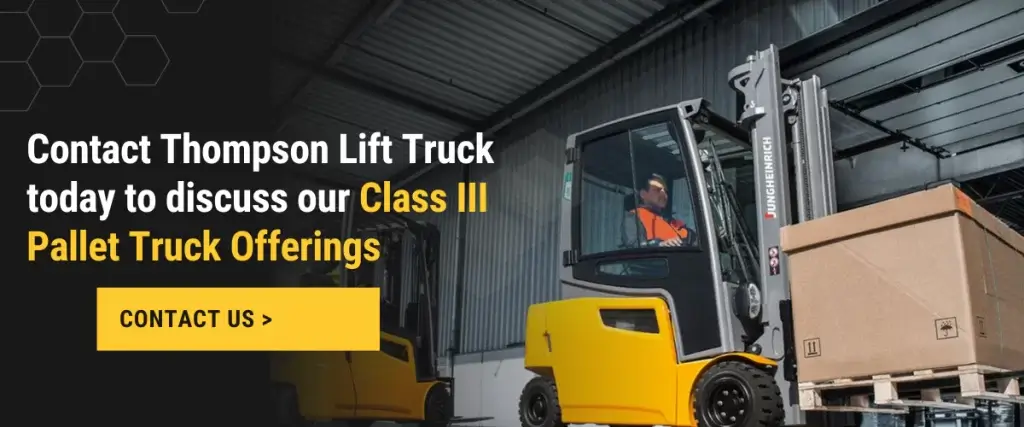
How to Choose the Right Class III Pallet Truck for Your Operation and Budget

When it comes to material handling, choosing the right Class III pallet truck can make a big difference in your operation’s productivity, safety, and bottom line. These electric-powered, walk-behind or rider pallet trucks are ideal for moving loads over short distances, but not every truck is right for every environment—or every budget.
In this guide, we’ll break down the main types of Class III pallet trucks, who they’re best suited for, and what to consider when making your choice.
What Are Class III Pallet Trucks?
Class III trucks are electric motor-powered hand trucks, commonly referred to as electric pallet jacks or powered pallet trucks. Designed to move palletized loads in tight spaces, they are typically used indoors on smooth surfaces and are operated by walking behind or riding on the truck.
According to OSHA, Class III includes:
- Walkie pallet jacks
- Rider pallet trucks
- End control and center control configurations
Your Options: Types of Class III Pallet Trucks
Let’s look at the four main styles you might be considering:
1. Walkie Pallet Truck (Standard Pull Type)
Best for: Light to medium-duty use in small warehouses, retail stockrooms, or delivery trucks.
Budget: Most affordable option.
These are the classic electric pallet jacks that operators walk behind. They’re easy to move, cost-effective, and great for facilities where travel distances are short.
Pros:
- Budget-friendly
- Simple to use
- Compact size for tight aisles
Cons:
- Not ideal for longer distances
- Operator fatigue over time

2. Rider Pallet Truck
Best for: High-volume warehouses or distribution centers with long travel distances.
Budget: Higher investment, but offers significant ROI in time saved.
These allow the operator to ride on the truck while transporting loads, increasing speed and efficiency in large operations.
Pros:
- Faster load transport
- Reduced operator fatigue
- Great for busy, large-scale environments
Cons:
- Higher upfront cost
- Requires more open space to operate safely

3. End-Control Pallet Truck
Best for: Applications that need enhanced visibility and control, like order picking or staging.
Budget: Mid-range
The operator stands at the end of the pallet truck, giving better visibility and maneuverability in some environments.
Pros:
- Better visibility
- Compact for tight spaces
- Great for cross-docking and staging
Cons:
- Not as comfortable for long hauls
4. Center-Control Pallet Truck
Best for: High-volume operations requiring frequent entry/exit and multi-directional travel.
Budget: Higher-end
These trucks place the operator in the center of the machine, offering protection, comfort, and excellent visibility.
Pros:
- Improved operator safety
- Ideal for repetitive pick/drop cycles
- Comfortable for longer shifts
Cons:
- Higher price point
- Not necessary for light-duty tasks
Key Considerations When Choosing a Pallet Truck
To choose the right Class III pallet truck for your needs, consider:
- Travel distance: Longer routes benefit from rider options.
- Frequency of use: Heavier usage may justify higher-end equipment.
- Load capacity needs: Match the truck’s specs to your typical pallet weights.
- Budget: Consider total cost of ownership, not just purchase price.
- Work environment: Narrow aisles or uneven flooring? That affects your options.
Need Help Deciding?
Choosing the right pallet truck can boost efficiency, reduce strain on your team, and cut down maintenance costs. Whether you’re outfitting a retail stockroom or upgrading a high-volume distribution center, Thompson Lift Truck can help you find the perfect match for your environment and budget.
